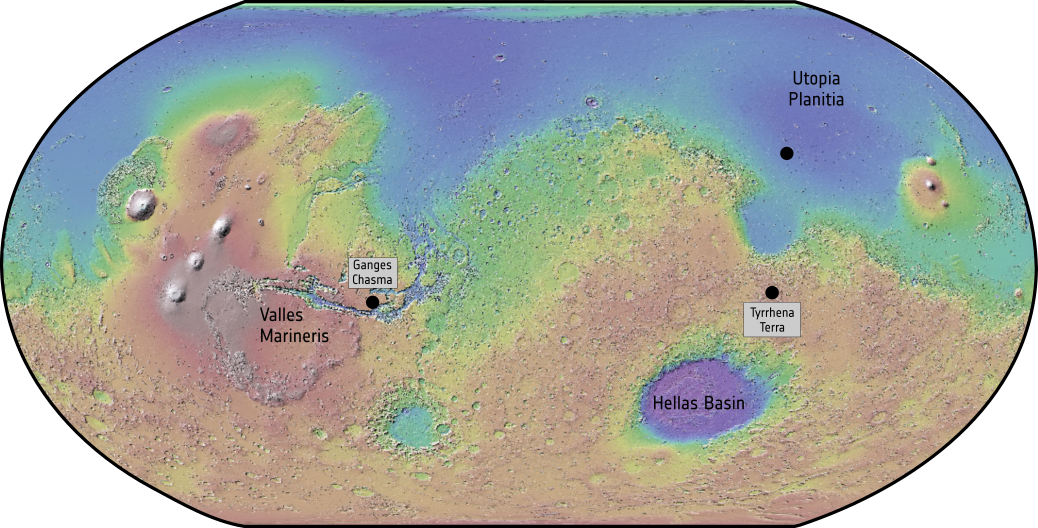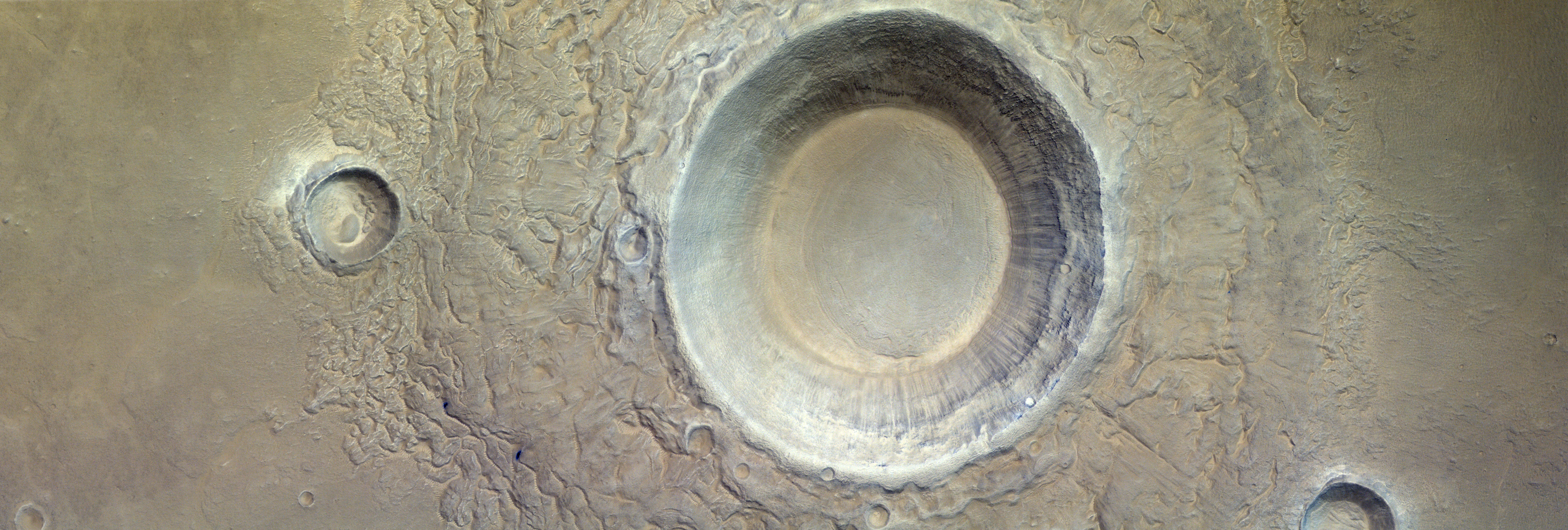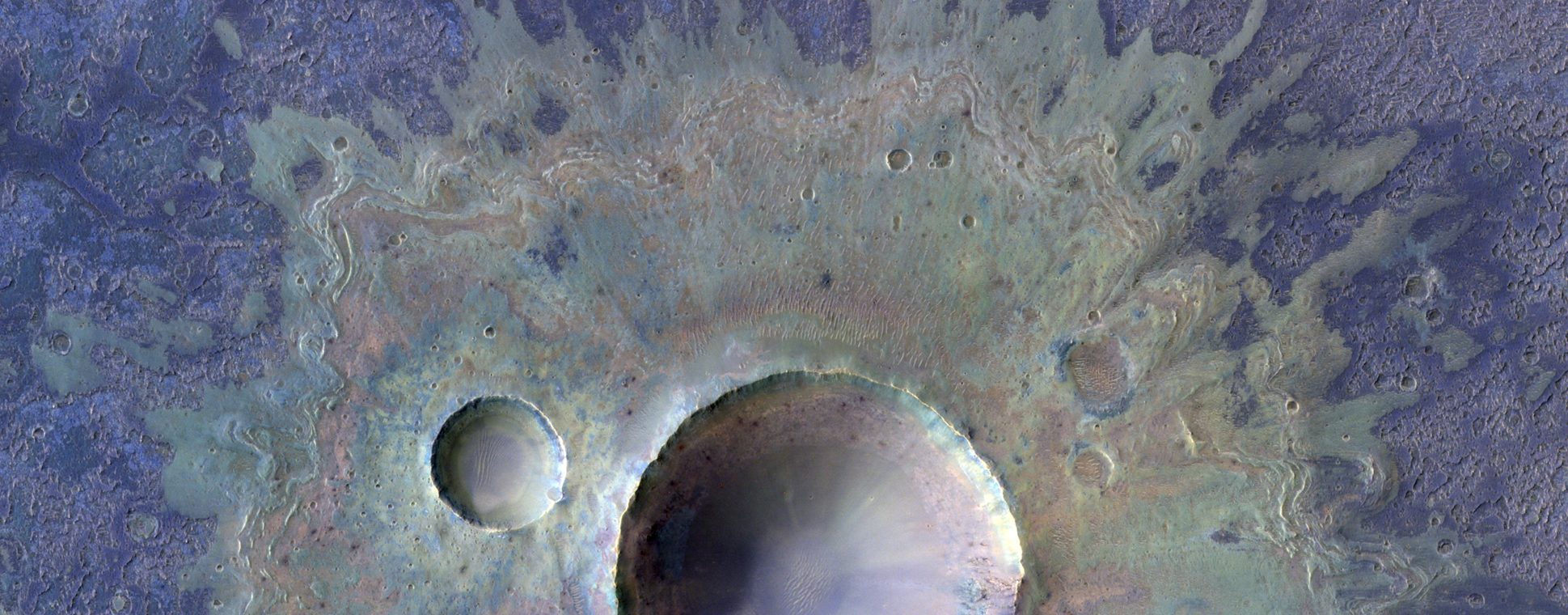Not all the scars on the martian surface have the same origin: some are a testament to its volcanic activity, but most of them are the result of rocky bodies impacting the Red Planet.
Mars is currently a cold, dry desert. In the ancient past, water, volcanoes and impacts from asteroids shaped the martian surface.

Map of Mars highlighting with dots the locations of the three craters featured in this article. Credits: ESA – E. Favaro
Thanks to the powers of CaSSIS (Colour and Stereo Surface Imaging System), the colour camera aboard the ExoMars Trace Gas Orbiter (TGO), scientists can analyse in detail the many scars inflicted upon the Red Planet, and the intriguing stories behind.
Join us on a special tour of intriguing martian craters with water traces and migrating dunes.
Eye of the crater
A vast cavity on the Red Planet looks back at ExoMars Trace Gas Orbiter (TGO) with an icy stare in this sweeping panorama. The crater sits in Utopia Planitia, the largest known impact basin in the Solar System with a diameter of roughly 3300 km, or twice the size of Earth’s Sahara Desert from north to south.
The region is known to scientists for showing intriguing ice-related features on and below the surface, including frost on the surface during the martian winter.
When ExoMars flew about 400 km above the crater – centered at 98.74°E, 34.37°N – it almost filled the full field of view of its most sophisticated colour camera, CaSSIS.
This view from CaSSIS shows a crater of about eight kilometres with material ejected in a way that scientists believe suggests the presence of water ice. When the asteroid hit this region of Mars, the water ice melted, and a mix of liquid water and dust rock was propelled from the top layers.
The smooth look of the crater is consistent with other features in the region having evidence of a water-ice history. Zooming into the crater it is possible to see streaks on the walls of the crater, showing evidence of landslides, and ripples sculpted by the wind.
Water meets crater
Along the equator of Mars, CaSSIS spotted a couple of interesting craters in Ganges Chasma, a mineralogically diverse canyon in the far-eastern portion of Valles Marineris.
This is a false colour image – the blue tones of this image do not represent the real colour of the crater floor. The tonalities are stretched to bring out information about mineral diversity, and include information from the infrared, which is invisible to the human eye.
Thanks to CaSSIS’s colour filters, scientists can highlight mineralogical or geologic differences on Mars’s surface that we would otherwise have difficulty distinguishing.
The shape and texture of the ejecta blanket show that the surface was not completely dry at the time of impact. Water ice in the subsurface mixed with fractured rock and dust formed a ‘fluidised’ mass of material that was ejected outwards from the centre of the impact site. This indicates that there was water ice present in the surface at the time of impact.
The colours in this image help reveal how the blanket of debris surrounding the four-kilometre impact crater is thinning in places. This provides us with information about the original surface beneath, as seen in small patches of blue poking through the greenish-pink blanket.
Next to the large crater sits a 1.2 km diameter crater. Its smooth rims and the fact that it sits on top of its neighbour’s ejecta blanket indicate that this is a younger crater that hit the Red Planet after the larger crater was formed.
Colourful dunes
In the southern highlands of Mars, CaSSIS has spotted ancient and eroded craters filled with sediment. This is the case of this relatively old, 15 km diameter crater in Tyrrhena Terra, showing its age in its flattened rim – younger craters have sharper, more defined rims – and the degraded ejecta blanket.
There is a central uplift section to the crater, as well as many smaller craters, which also suggests an advanced age.
Beautiful dark dunes appear in contrast with wind-blown, pinkish ripples winding their way around the terrain.
Like most CaSSIS imagery, the colours in this image are stretched to highlight the diversity of surface composition.
Mars in high-res
For six years CaSSIS has been observing Mars in astonishing colour, beaming back to Earth images of volcanic landscapes, colossal sand dunes and active dust devils. Understanding the history of water on Mars and if this once allowed life to flourish is at the heart of ESA’s ExoMars missions.
TGO’s full science mission began in 2018. The spacecraft is not only returning spectacular images, but also providing the best inventory of the planet’s atmospheric gases and mapping the planet’s surface for water-rich locations.




Discussion: no comments